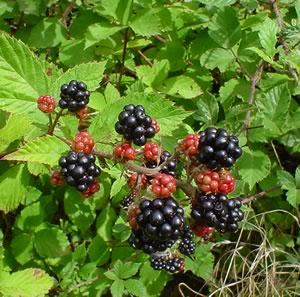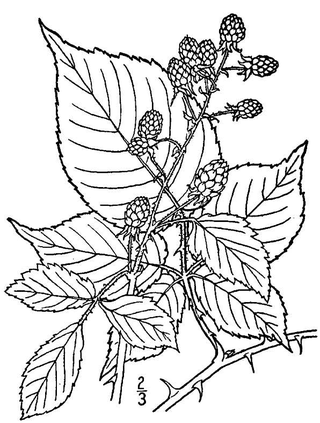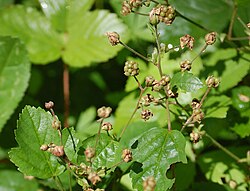
Rubus is a large and diverse genus of flowering plants in the rose family, Rosaceae, subfamily Rosoideae, with over 1,350 species.

The dewberries are a group of species in the genus Rubus, section Rubus, closely related to the blackberries. They are small trailing brambles with aggregate fruits, reminiscent of the raspberry, but are usually purple to black instead of red. Alternatively, they are sometimes referred to as ground berries.

The boysenberry is a cross between the European raspberry, European blackberry, American dewberry, and loganberry.

The loganberry is a hybrid of the North American blackberry and the European raspberry.

Rubus phoenicolasius is an Asian species of raspberry in the rose family, native to China, Japan, and Korea.

Rubus caesius is a Eurasian species of dewberry, known as the European dewberry. Like other dewberries, it is a species of flowering plant in the rose family, related to the blackberry and raspberry. It is widely distributed across much of Europe and Asia from Ireland and Portugal as far east as Xinjiang Province in western China. It has also become sparingly naturalized in scattered locations in Argentina, Canada, and the United States.

Rubus occidentalis is a species of Rubus native to eastern North America. Its common name black raspberry is shared with other closely related species. Other names occasionally used include bear's eye blackberry, black cap, black cap raspberry, and scotch cap.
Dewberry is a group of species in the genus Rubus, closely related to the blackberries.

Rubus armeniacus, the Himalayan blackberry or Armenian blackberry, is a species of Rubus in the blackberry group Rubus subgenus Rubus series Discolores Focke. It is native to Armenia and Northern Iran, and widely naturalised elsewhere. Both its scientific name and origin have been the subject of much confusion, with much of the literature referring to it as either Rubus procerus or Rubus discolor, and often mistakenly citing its origin as western European. Flora of North America, published in 2014, considers the taxonomy unsettled, and tentatively uses the older name Rubus bifrons.

Rubus ursinus is a North American species of blackberry or dewberry, known by the common names California blackberry, California dewberry, Douglas berry, Pacific blackberry, Pacific dewberry and trailing blackberry.

Rubus pubescens is a herbaceous perennial widespread across much of Canada and the northern United States, from Alaska to Newfoundland, south as far as Oregon, Colorado, and West Virginia.

Rubus flagellaris, the northern dewberry, also known as the common dewberry, is a North American species perennial subshrub species of dewberry, in the rose family. This dewberry is distributed across much of Canada, Mexico, and the United States. It grows in diverse habitats ranging from drier savannas to temperate deciduous forests.

Rubus allegheniensis is a North American species of highbush blackberry in section Alleghenienses of the genus Rubus, a member of the rose family. It is the most common and widespread highbush blackberry in eastern and central North America. It is commonly known as Allegheny blackberry.
Rubus adjacens, the peaty dewberry, is a rare North American species of flowering plant in the rose family. It is native to eastern Canada and the northeastern and east-central United States (Maine, New Hampshire, Vermont, Massachusetts, New York, Pennsylvania, Maryland.
Rubus furtivus is an uncommon North American species of flowering plant in the rose family. It grows in northeastern United States, having been found only in the state of New York.
Rubus permixtus is an uncommon North American species of flowering plant in the rose family. It grows in scattered locations in the north-central and northeastern United States, from Maine south as far as West Virginia plus Michigan and Wisconsin. Nowhere is it very common.
Rubus segnis is an uncommon North American species of flowering plant in the rose family. It grows in eastern Canada and the northeastern United States. Nowhere is it very common.
Rubus vigoratus is an uncommon North American species of flowering plant in the rose family. It grows in Nova Scotia and Massachusetts. Nowhere is it very common.













